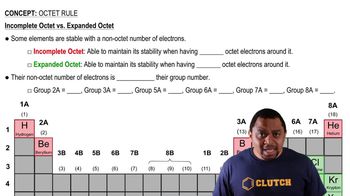Could the strain in the P4 molecule be reduced by using sp3 hybrid orbitals in bonding instead of pure p orbitals? Explain.
Ch.22 - The Main Group Elements
Chapter 22, Problem 138b
Account for each of the following observations.
b. SF4 exists, but OF4 does not.

Verified Solution
Video duration:
0m:0sWas this helpful?
Key Concepts
Here are the essential concepts you must grasp in order to answer the question correctly.
Valence Shell Electron Pair Repulsion (VSEPR) Theory
VSEPR theory is used to predict the geometry of molecular structures based on the repulsion between electron pairs around a central atom. In the case of SF4, the sulfur atom has six valence electrons, allowing it to form four bonds with fluorine and maintain a stable structure with a seesaw shape. Conversely, OF4 would require oxygen to accommodate four bonds, which is not feasible due to its limited valence electrons.
Recommended video:
Guided course

Valence Shell Electron Pair Repulsion Theory
Electronegativity and Bonding
Electronegativity refers to the tendency of an atom to attract electrons in a bond. Sulfur is less electronegative than fluorine, allowing SF4 to form stable covalent bonds. In contrast, oxygen is more electronegative than sulfur, leading to instability in OF4 as the oxygen atom would struggle to form four stable bonds without exceeding its octet.
Recommended video:
Guided course

Electronegativity Trends
Molecular Stability and Octet Rule
The octet rule states that atoms tend to form bonds in such a way that they have eight electrons in their valence shell, achieving a stable electron configuration. SF4 adheres to this rule, while OF4 does not, as oxygen can only accommodate a maximum of two additional electrons in its valence shell, making the formation of OF4 energetically unfavorable and unstable.
Recommended video:
Guided course

Octet Rule
Related Practice
Textbook Question
Textbook Question
Arrange the following oxides in order of increasing covalent character: B2O3, BeO, CO2, Li2O, N2O5.
Textbook Question
Describe the structure of the sulfur molecules in:
b. Monoclinic sulfur
Textbook Question
Little is known about the chemistry of astatine (At) from direct observation, but reasonable predictions can be made.
(a) Is astatine likely to be a gas, a liquid, or a solid?
92
views
Textbook Question
Niobium reacts with fluorine at room temperature to give a solid binary compound that is 49.44% Nb by mass.
(c) The compound reacts with hydrogen to regenerate niobium. Write a balanced equation for the reaction.
110
views
Textbook Question
Chlorine reacts with molten sulfur to yield disulfur dichloride, a yellowish-red liquid. Propose a structure for disulfur dichloride.
105
views
